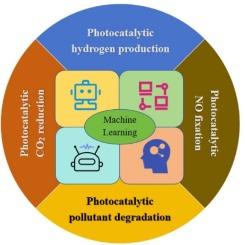机器学习在光催化领域应用的研究进展
IF 5.9
3区 工程技术
Q1 CHEMISTRY, MULTIDISCIPLINARY
Journal of Industrial and Engineering Chemistry
Pub Date : 2025-04-24
DOI:10.1016/j.jiec.2025.04.039
引用次数: 0
摘要
光催化是一种利用太阳能驱动化学反应的技术,通过光催化剂在光照射条件下促进氧化还原反应,实现污染物的净化、物质的合成和转化等。光催化技术的核心是光催化剂。然而,传统的光催化材料的试错开发过程由于成本高、效率低、研发周期长等不利因素,已经不能满足现代社会的发展需求。近年来,机器学习(ML)技术的快速发展为光催化剂的设计开辟了新的途径。随着大数据与人工智能(AI)的不断深度融合,以数据为驱动的机器学习在新材料的设计、筛选、性能预测等方面取得了巨大进展,极大地推动了新材料的研究与应用。本文首先介绍了ML的基本过程及其在材料科学中的常用算法,然后重点介绍了近年来ML在光催化水裂解制氢、光催化污染物降解、光催化有害气体转化等方面的最新研究进展。并对ML在光催化剂筛选与设计、光催化性能预测、光催化工艺参数优化等方面存在的问题及发展前景进行了展望。本文章由计算机程序翻译,如有差异,请以英文原文为准。

Research progress of machine learning in the field of photocatalysis applications
Photocatalysis is a technology that uses solar energy to drive chemical reactions, and it promotes oxidation–reduction reactions under the condition of light irradiation by photocatalysts, achieving the purification of pollutants, synthesis and transformation of substances, and so on. The essence of photocatalytic technology centers on photocatalysts. Nevertheless, the traditional trial-and-error development process of photocatalytic materials cannot meet the development needs of modern society due to unfavorable factors such as high cost, low efficiency, and lengthy research and development periods. In recent times, the fast advancement of machine learning (ML) technology has opened up new avenues for the design of photocatalysts. With the continuous deep integration of big data and artificial intelligence (AI), machine learning, which is data-driven, has made tremendous progress in the design, screening, and performance prediction of new materials, greatly promoting the research and application of novel materials. This review first introduces the basic process of ML and its commonly used algorithms in materials science, and then focuses on the latest research progress in the use of ML in photocatalytic water splitting for hydrogen production, photocatalytic pollutant degradation, and photocatalytic harmful gas conversion in recent years. Furthermore, it provides a prospect on the existing problems and development prospects of ML in the screening and design of photocatalysts, the prediction of photocatalytic performance, the parameter optimization of photocatalytic processes, and so on.
求助全文
通过发布文献求助,成功后即可免费获取论文全文。
去求助
来源期刊
CiteScore
10.40
自引率
6.60%
发文量
639
审稿时长
29 days
期刊介绍:
Journal of Industrial and Engineering Chemistry is published monthly in English by the Korean Society of Industrial and Engineering Chemistry. JIEC brings together multidisciplinary interests in one journal and is to disseminate information on all aspects of research and development in industrial and engineering chemistry. Contributions in the form of research articles, short communications, notes and reviews are considered for publication. The editors welcome original contributions that have not been and are not to be published elsewhere. Instruction to authors and a manuscript submissions form are printed at the end of each issue. Bulk reprints of individual articles can be ordered. This publication is partially supported by Korea Research Foundation and the Korean Federation of Science and Technology Societies.

 求助内容:
求助内容: 应助结果提醒方式:
应助结果提醒方式:


